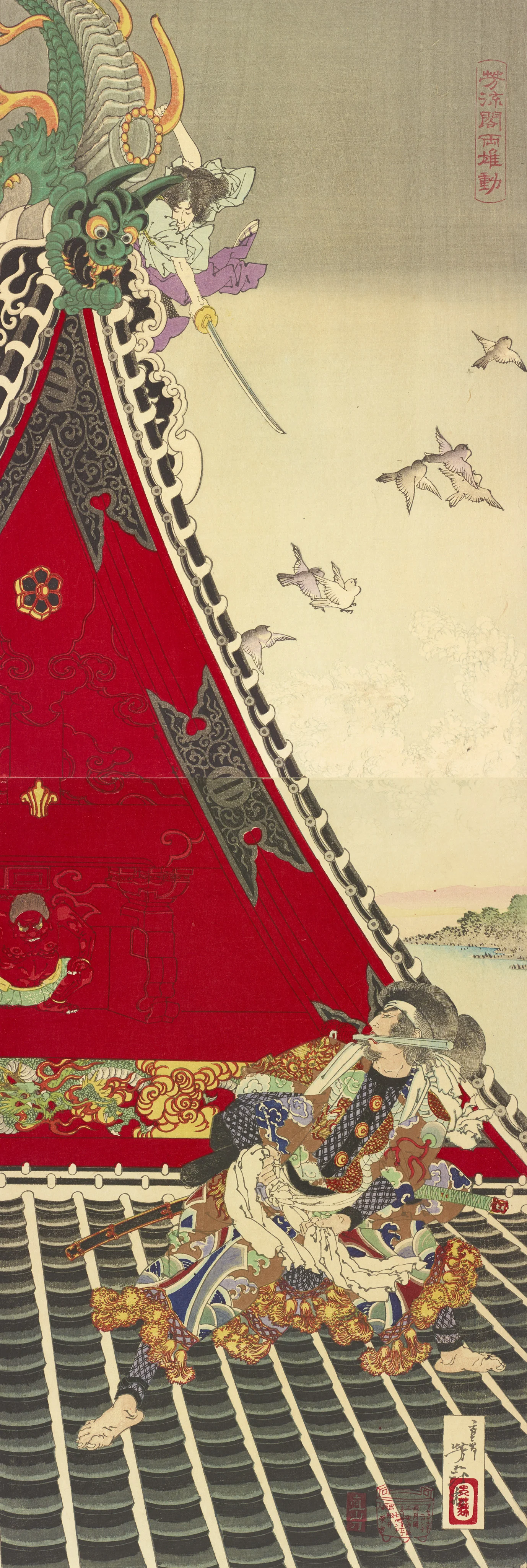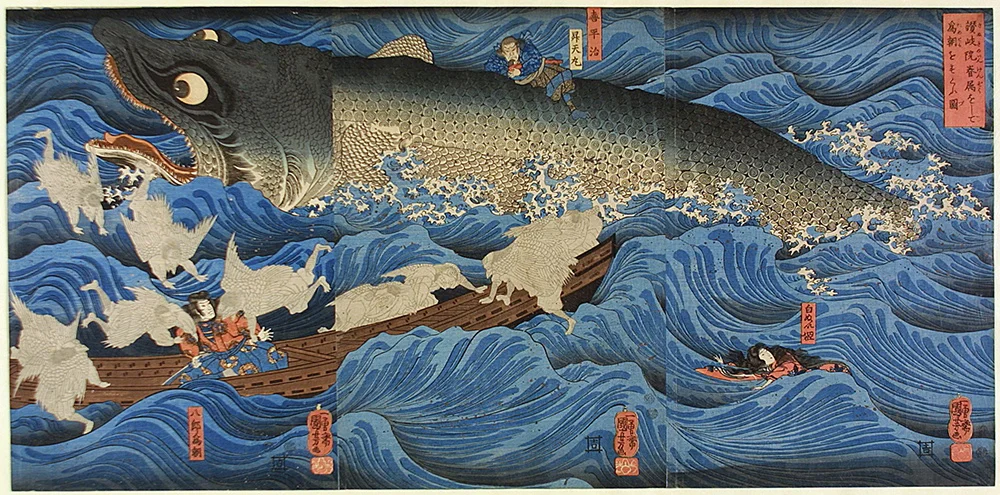A story goes that hundreds of years ago, the hand of a princess was offered to the warrior who could defeat the enemies of a certain clan. This doubtless seemed like a romantic ideal until the triumphant victor turned out to be a dog. In ways that are kept blissfully vague in all synopses, the couple wed and live as husband and wife. Faced with the (really quite understandable) horror of giving birth, the princess dies. As she exits this mortal coil, eight beads pass from her (she may have been wearing these as jewellery or .... not. Descriptions differ and I'm not even sorry) and find their way into eight newborn babies. These changeling dog children ultimately meet and restore their family's clan.
I heard once that there are no new stories, only retelling of those already in existence. However, while the above Japanese tale is thought to be based on the Chinese myth on Panhu, I think it has to be safe to say it's one of the less used plot lines.
Utagawa Kuniyoshi “Fight on the Roof of the Hōryūkaku from the Hakkenden”.
Let's keep it that way.
This disturbing story is entitled "Nansō Satomi Hakkenden" which is translated to "Tale of the Eight Dog Warriors of the Satomi Clan" or "The Story of the Eight Samurai". The author is Kyokutei Bakin, a pen name pun whose Kanji (Chinese characters) can also be interpreted as "a man devoted to the courtesans of the pleasure districts".
Bakin's true birth name was Takizawa Okikuni and he was born in 1726 as the fifth son of a samurai. While not his first work, the Eight Samurai tale is perhaps his most famous. It is a story of epic proportions, written by Bakin over 28 years beginning in 1814 when he was 48 years old. At 75, he went blind and dictated the remains of the tale to his daughter-in-law, Omichi. He died aged 82, leaving behind his magnum opus in 106 volumes published over 29 years.
Bakin's original writing of the Eight Samurai is not supposed to have been terribly readable, both from a choice in wording (kanji) and allegories. It might never have reached the popular success that allowed it to persevere through the centuries if it had not been for the illustrated versions. A digest version of the tale was produced, loaded with black and white drawings penned by a series of artists that most prominently included Yanagawa Shigenobu, an artist (by-the-by) who was also known for his erotic illustrations[*]. The originals of these books look like beautiful manga, but it is the ukiyo-e prints that are best remembered.
Ukiyo-e is traditional Japanese art from the 17th - 19th centuries produced using woodblock prints. Unlike other forms of art, ukiyo-e was popular with the lower social classes, and it frequently depicts a detailed view of ordinary people's lives, manners and landscapes. As such, it has become a valuable resource for studying the Edo period in Japan.
The Ota Memorial Museum of Art in Ometesando, Tokyo, has a collection of 12,000 ukiyo-e pieces that once belonged to an insurance company president, Seizo Ota. Ota became a fan of the ukiyo-e style as a college student and acquired pieces throughout his life. Since the colourful pigments risk fading in light, the museum rotates the pieces and keeps lighting down, banning the use of cameras and electronic equipment.
Utagawa Kunisada “Fight on the Roof of the Hōryūkaku : Inukai Genpachi / Inuzuka Shino.”
I was also required to remove my heelys when walking on the tatami section of the display hall. Can't imagine why.
To mark Kyokutei Bakin's 250th birthday, the museum is focussed on 80 ukiyo-e prints that depict the Eight Samurai tale and Bakin's other stories. Ukiyo-e prints depicting scenes from books were relatively rare. The production of these may have been linked to the story's popular rendition as a kabuki performance; a traditional Japanese theatrical drama, recognisable for its highly stylised white make-up. Ukiyo-e frequently depicted kabuki actors, but while the figures in the Eight Samurai ukiyo-e on display resembled the kabuki style, it was not clear to me from the descriptions which had come first: the Eight Samurai kabuki or the Eight Samurai kabuki ukiyo-e.
In one scene of the Eight Samurai, there is a roof battle between two warriors. Being equally matched, both fail to secure a victory but fall from the building. The scene is depicted in three different ukiyo-e displayed at the museum, each drawn by different artists. The work of Tsukioka Yoshitoshi is the illustration at the top of the post. It could be the most famous since I feel I have seen it displayed on multiple occasions. His teacher, Utagawa Kuniyoshi, designed a second representation that was my favourite; the two warriors look capable of wielding weapons and a dragon has been added into the frame and looks ready to crack open a bucket of popcorn in order to watch the fun.
The third version was by Utagawa Kunisada (the shared family name, 'Utagawa', I believe was adopted by both Kunisada and Kunitoshi from the name of the school that taught them their craft). This version is in clear Kabuki style, with the faces of the figures oversized and white while their clothes look far too elaborate and bulky for anything they are attempting to achieve with their sword. Admittedly, the latter observation was generally true throughout the ukiyo-e prints; it is hardly surprising these battles were prolonged and inconclusive.
Utagawa Kuniyoshi, 'The Rescue of Minamoto no Tametomo by Goblins'.
Other work based on Bakin's stories included another famous ukiyo-e by Utagawa Kuniyoshi. In this story, a giant sea monster threatens a ship. To appease the angry waters, the princess onboard hurls herself into the waves as a sacrifice.
In a unexpected show of realism, this does as much as you might expect.
The protagonist of the tale is about to follow suit, when he is conveniently rescued by tengu; mythical goblins that can fly. Presumably, this is considered lucky but without the subsequent scenes of how this turned out for him, we are left to speculate.
This particular display of Baskin-themed works runs at the museum until June 25th, but the museum presumably rotates in other ukiyo-e from their collection after this time.
--
[*] Google it. You know you want to.



